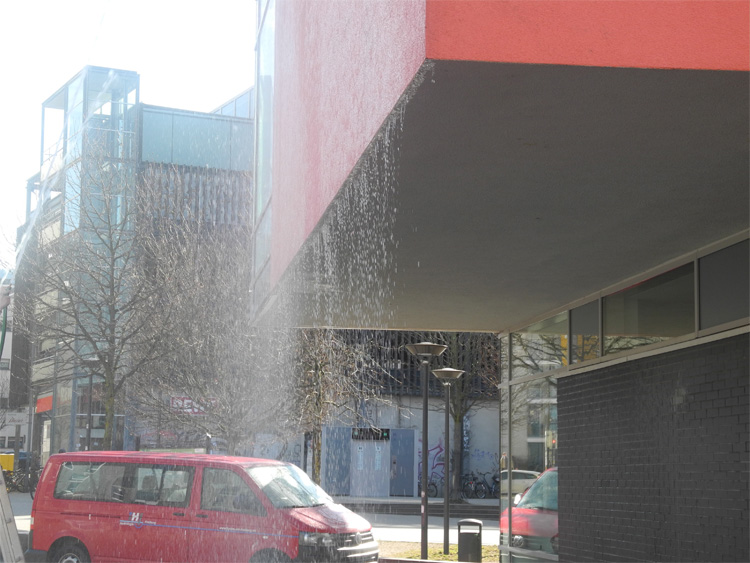Algae rather than toxins on facades
Freiburg, Aug 03, 2022
Many facades contain biocides. These are toxins that inhibit the growth of algae and fungi on walls. Rainwater can wash these biocides out of the facade paints, allowing the toxins to find their way into the groundwater. “Some of these toxins originate from agriculture and their use as pesticides has already been forbidden. But they are still used on facades,” says Prof. Dr. Jens Lange, a hydrologist at the University of Freiburg’s Faculty of Environment and Natural Resources. Lange leads an interdisciplinary project that has developed strategies to reduce the use of such substances in facade paints.
 Facade sprinkling experiment in the Vauban district of Freiburg. The researchers were able to measure biocides and transformation products in the dripping water. Credit: Jens Lange
Facade sprinkling experiment in the Vauban district of Freiburg. The researchers were able to measure biocides and transformation products in the dripping water. Credit: Jens Lange
“In order to achieve our goals of the project, we cooperated with sociologists from the University of Strasbourg,” says Prof. Dr. Jens Lange, “because we already noticed during earlier projects, that when it comes to this issue, solutions depend on more than technology. ”Inter alia, the sociologists from Strasbourg surveyed people about the significance of their building’s appearance to them. They also interviewed painting companies about their work methods. Leuphana University Lüneberg and the University of Koblenz-Landau as well as an engineering company have also taken part in the EU-financed INTERREG project, which began in 2019. Abbreviated as NAVEBGO, the name stands for “Sustainable Reduction of Biocide Input into the Groundwater of the Upper Rhine”.
Another hydrologist from the University of Freiburg, Dr. Marcus Bork, coordinated the project. He says, “Wind-driven rain, above all, can wash off biocides so that they reach the environment via runoff.” Most modern residential areas have separate sewage systems. Dirty wastewater from the buildings runs in sanitary sewers to a wastewater treatment plant. The rain, however, seeps into graveled surfaces along building walls or drainage ditches, for example. This is actually a good thing, because it’s a way valuable rainwater becomes a benefit for plants and the groundwater. But if the water contains biocides that have washed out of paints, that’s a problem, especially because some of them degrade into transformation products. “A biocide can form a whole bouquet of new substances that are sometimes more poisonous to the environment than the initial product,” explains Bork.
Evidence of biocides in groundwater
The groundwater is particularly threatened if it is close to the surface because then the rain was only filtered by thin soil layers. This is the case, for example, in the Vauban district of Freiburg, where the researchers could actually demonstrate the presence of common biocides in the groundwater. Lange says that it is “almost impossible” to use filtering systems to remove these substances and their degradation products from the water. He continues, “That’s why our project virtually addressed the source – and developed measures in order to eliminate the use of these substances, if at all possible,” he adds.
Residents’ perceptions played a key role. Algae and fungi do not damage a facade structurally, says Lange. But for many people, overgrown walls gave the impression of a building that was poorly maintained, and in part, unsafe, and this perception was often transferred to the people who live in the building. Says Lange, “They no longer feel comfortable in their homes.” As a result, he continues, painting companies are then called in to ensure that facades are free of fungi and algae. To do this, the companies frequently used ready-made products from their suppliers, render, for example, made of silicon resin, including integrated biocides to be used as a so-called protective coating. Lange added, “The workers often don’t exactly know at all, what kind of substances are included.”
 Infiltration trough in the Freiburg district of Wiehre. Biocides were also detectable here, albeit in low concentrations. Credit: Jens Lange
Infiltration trough in the Freiburg district of Wiehre. Biocides were also detectable here, albeit in low concentrations. Credit: Jens Lange
Regulatory proposals for policymakers
In order to reduce the use of biocides on building exteriors, the project has therefore proposed a package of different measures. For one thing, says Lange, policymakers could intervene to regulate, and expand environmental labeling programs such as the “Blue Angel”. He adds, they could also demand that products containing biocides could be made more expensive or banned. Another measure would be to change the guarantee obligations of painting companies. Says Lange, “Like they now do with wood structures – there, owners are also responsible for maintenance.”
Traditional techniques for the painting trade could be promoted as well. “There are classic mineral-based rather than petroleum-based products, these are more alkali and breathable, and where fungi and algae can rarely grow. But working with them is a little bit more complicated,” says Lange. And finally, concludes Lange, they could rely on a change in consciousness and innovation. “If you intentionally put microalgae on facades that cool in summer and contribute to a healthy urban climate, then those are no longer pests that have to be controlled.”
Algae and fungi are part of urban ecosystem of the future
At the project’s closing event, there was a great deal of interest – from architects for example – for such models. The city of Freiburg, says the project leader, is already supporting “facade greening” projects that have a similar effect. Lange adds, Germany’s Federal Environmental Office, the “Umweltbundesamt” has already expressed an interest in the results as well. “With this project, we want to make a contribution along the route to a biocide-free city,” says Lange. “Our vision is that algae and fungi should no longer be seen as pests, but as a part of the urban ecosystem of the future,” he says.
Thomas Goebel

